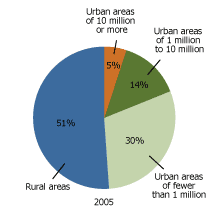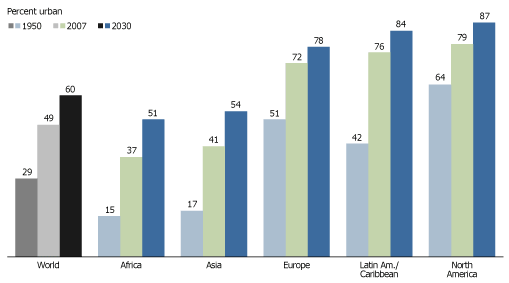
World Population Highlights 2007: Urbanization
Date
August 16, 2007
Author
(September 2007) The world is on the verge of a shift: from predominantly rural to mainly urban. In 2008, more than half the world’s people will live in urban areas.
By 2030, urban dwellers will make up roughly 60 percent of the world’s population.
The world’s regions differ greatly in their levels of urbanization. In North America, Europe, and Latin America and the Caribbean, more than 70 percent of the population is already urban; but in Africa and Asia, less than 40 percent of the population is urban.
Just 5 Percent of the World’s Population Lives in Urban Areas of 10 Million of More.

Source: United Nations, World Population Prospects: The 2006 Revision (2007).
Where Will Populations Grow?
Contrary to popular belief, the bulk of urban population growth is likely to occur in smaller cities and towns of less than 500,000. Globally, all future population growth will take place in cities, especially in Asia, Africa, and Latin America. In Asia and Africa, this growth will signal a shift from rural to urban growth, changing a millennia-long trend.
Between 2000 and 2030, the urban population in Africa and Asia is set to double. Asia’s urban population will grow from 1.4 billion to 2.6 billion. Africa’s will surge to more than twice its size, from 294 million to 742 million. Latin America and the Caribbean will see its urban population rise from 394 million to 609 million. By 2030, 79 percent of the world’s urban dwellers will live in the developing world’s towns and cities. And Africa and Asia will account for almost seven in every 10 urban inhabitants globally.
Poor people will make up a large part of future urban growth. Most urban growth is due to natural increase (more births than deaths) rather than migration.
By 2030, Nearly Two-Thirds of the World’s Population Will Live in Urban Areas.

Source: United Nations, World Urbanization Prospects: The 2005 Revision (2006) and Carl Haub, 2007 World Population Data Sheet.
Largest Urban Areas
The largest cities in the world are slowly growing in size, and increasingly they are located in less developed regions. In 1950, the three largest cities were New York-Newark (12.3 million), Tokyo (11.3 million), and London (8.4 million). By 2015, the UN projects that Mumbai and Mexico City will have replaced London and New York-Newark in the top three: Tokyo at 35.5 million, Mumbai at 21.9 million, and Mexico City at 21.6 million.
While slightly more than 9 percent of urban dwellers live in cities of 10 million or more people, about 62 percent live in cities of 1 million or fewer. About 52 percent of urbanites overall live in cities of fewer than 500,000 residents.
Not all cities in the world would feel like a city to outsiders. While high-rise living, skyscrapers, and modern transportation and sanitary facilities may be common in cities in the developed world, other urban areas are far different. In the slums of Lagos, Nigeria, dirt paths are the main way to get around. In India, 31 percent of urban households do not have a bathroom facility in the house.
How Does Urbanization Affect the Environment?
Urban people change their environment through their consumption of food, energy, water, and land. In turn, the polluted urban environment affects the health and quality of life of the urban population.
People who live in urban areas have very different consumption patterns than residents of rural areas. For example, urban populations consume much more food, energy, and durable goods than rural populations. In China during the 1970s, the urban populations consumed more than twice as much pork as the rural populations who were raising pigs.
By extension, the energy consumption for electricity, transportation, cooking, and heating is much higher in urban areas than in rural villages. For example, urban populations have many more cars than rural populations per capita.
The urbanization of the world’s populations will increase aggregate energy use. And the increased consumption of energy is likely to affect the environment.
Urban consumption of energy creates heat islands that can change local weather patterns and weather downwind from the heat islands. The heat island phenomenon is created as cities radiate less heat back into the atmosphere than rural areas, making cities warmer than rural areas. These heat islands trap atmospheric pollutants. Cloudiness and fog occur more often. Precipitation is 5 percent to 10 percent higher in cities, and thunderstorms and hailstorms are much more frequent.
Urbanization also affects environments beyond the city. Regions downwind from large industrial complexes see increases in the amount of precipitation, air pollution, and the number of days with thunderstorms. Urban areas also affect water runoff patterns. Not only do urban areas generate more rain, they reduce the infiltration of water and lower the water tables. This means that runoff occurs more quickly with greater peak flows. Flood volumes increase, as do floods and water pollution downstream.
Many of the effects of urban areas on the environment are not necessarily linear. Bigger cities do not always lead to more environmental problems and small urban areas can cause large problems.
Density is potentially beneficial. With world population growing by about 82 million a year, demographic concentration makes sustainability more likely. Global urban expansion takes less land than land lost every year to agriculture, forestry, and grazing, or to erosion and salinization.
Case In Point
How do you define urban? It depends. Definitions differ from one country or area to the next. For Peru, populated centers of 100 or more dwellings are considered urban. In contrast, it takes a lot more for an area to be designated a city in Japan, where cities must be home to 50,000 or more inhabitants with 60 percent or more of the houses located in the main built-up areas and 60 percent or more of the population (including their dependents) engaged in manufacturing, trade, or other urban kinds of business.
In Mongolia, the capital and district centers are the cities. In South Africa, places where some form of local authority exists count as cities.
In other places, urban is defined by available services. By 1970, Panama’s urban areas included localities of 1,500 or more inhabitants, and had such urban characteristics as streets, water supply systems, sewage systems, and electricity.
Sometimes what helps distinguish urban from rural areas is the nature of the population, particularly the extent to which it is nonagricultural. In Botswana, an agglomeration of 5,000 or more inhabitants where 75 percent of the economic activity is nonagricultural is classified as urban.
Sources
Carl Haub, 2007 World Population Data Sheet (Washington, DC: Population Reference Bureau, 2007).
George Martine, The State of World Population 2007: Unleashing the Potential of Urban Growth (New York: United Nations, 2007).
Office of the Registrar General, India; “Census of India 2001: Table S00-017: Distribution of Households by Availability of Bathroom, Type of Latrine Within the House and Type of Drainage Connectivity for Waste Water Outlet,” accessed online at www.censusindia.net, on July 6, 2007.
Barbara Boyle Torrey, “Urbanization: An Environmental Force to Be Reckoned With,” accessed online at www.prb.org, on June 26, 2007.
United Nations, World Urbanization Prospects: The 2005 Revision (New York: United Nations, 2006).
United Nations, 2003 Demographic Yearbook (New York: United Nations, 2006).
